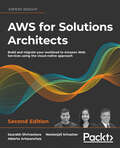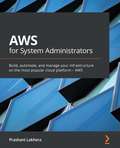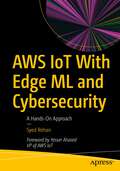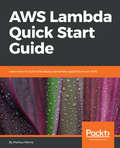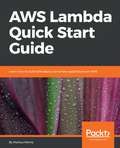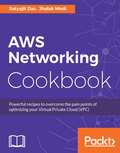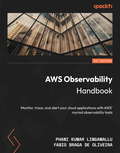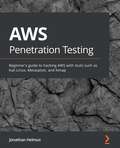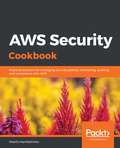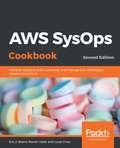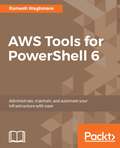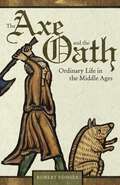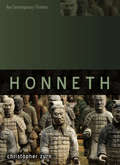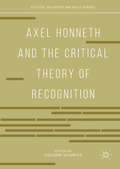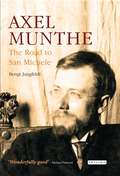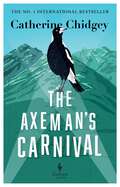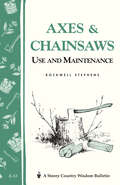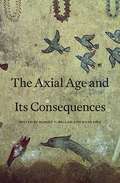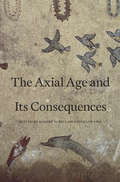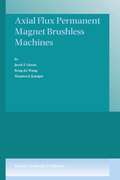- Table View
- List View
AWS for Solutions Architects: The definitive guide to AWS Solutions Architecture for migrating to, building, scaling, and succeeding in the cloud
by Alberto Artasanchez Saurabh Shrivastava Neelanjali Srivastav Imtiaz SayedAre you excited to harness the power of AWS and unlock endless possibilities for your business? Look no further than the second edition of AWS for Solutions Architects! Packed with all-new content, this book is a must-have guide for anyone looking to build scalable cloud solutions and drive digital transformation using AWS. This updated edition offers in-depth guidance for building cloud solutions using AWS. It provides detailed information on AWS well-architected design pillars and cloud-native design patterns. You'll learn about networking in AWS, big data and streaming data processing, CloudOps, and emerging technologies such as machine learning, IoT, and blockchain. Additionally, the book includes new sections on storage in AWS, containers with ECS and EKS, and data lake patterns, providing you with valuable insights into designing industry-standard AWS architectures that meet your organization's technological and business requirements. Whether you're an experienced solutions architect or just getting started with AWS, this book has everything you need to confidently build cloud-native workloads and enterprise solutions.Key FeaturesGain expertise in automating, networking, migrating, and adopting cloud technologies using AWSUse streaming analytics, big data, AI/ML, IoT, quantum computing, and blockchain to transform your businessUpskill yourself as an AWS solutions architect and explore details of the new AWS certificationWhat you will learnOptimize your Cloud Workload using the AWS Well-Architected FrameworkLearn methods to migrate your workload using the AWS Cloud Adoption FrameworkApply cloud automation at various layers of application workload to increase efficiencyBuild a landing zone in AWS and hybrid cloud setups with deep networking techniquesSelect reference architectures for business scenarios, like data lakes, containers, and serverless appsApply emerging technologies in your architecture, including AI/ML, IoT and blockchainWho this book is forThis book is for application and enterprise architects, developers, and operations engineers who want to become well versed with AWS architectural patterns, best practices, and advanced techniques to build scalable, secure, highly available, highly tolerant, and cost-effective solutions in the cloud. Existing AWS users are bound to learn the most, but it will also help those curious about how leveraging AWS can benefit their organization. Prior knowledge of any computing language is not needed, and there’s little to no code. Prior experience in software architecture design will prove helpful.
AWS for System Administrators: Build, automate, and manage your infrastructure on the most popular cloud platform – AWS
by Prashant LakheraTake your AWS SysOps skills to the next level by learning infrastructure automation techniques using CloudFormation, Terraform, and Boto3Key FeaturesExplore AWS automation using CloudFormation, Terraform, and Boto3Leverage AWS to make your infrastructure flexible and highly availableDiscover various AWS features for building a secure and reliable environment to host your applicationBook DescriptionAmazon Web Services (AWS) is one of the most popular and efficient cloud platforms for administering and deploying your applications to make them resilient and robust. AWS for System Administrators will help you to learn several advanced cloud administration concepts for deploying, managing, and operating highly available systems on AWS. Starting with the fundamentals of identity and access management (IAM) for securing your environment, this book will gradually take you through AWS networking and monitoring tools. As you make your way through the chapters, you'll get to grips with VPC, EC2, load balancer, Auto Scaling, RDS database, and data management. The book will also show you how to initiate AWS automated backups and store and keep track of log files. Later, you'll work with AWS APIs and understand how to use them along with CloudFormation, Python Boto3 Script, and Terraform to automate infrastructure. By the end of this AWS book, you'll be ready to build your two-tier startup with all the necessary infrastructure, monitoring, and logging components in place.What you will learnAdopt a security-first approach by giving users minimum access using IAM policiesBuild your first Amazon Elastic Compute Cloud (EC2) instance using the AWS CLI, Boto3, and TerraformSet up your datacenter in AWS Cloud using VPCScale your application based on demand using Auto ScalingMonitor services using CloudWatch and SNSWork with centralized logs for analysis (CloudWatch Logs)Back up your data using Amazon Simple Storage Service (Amazon S3), Data Lifecycle Manager, and AWS BackupWho this book is forThis Amazon Web Services book is for system administrators and solution architects who want to build highly available and flexible AWS Cloud platforms for their applications. Software engineers and programmers looking to deploy their applications to AWS Cloud will also find this book useful. Basic knowledge of Linux and AWS is necessary to get started.
AWS IoT With Edge ML and Cybersecurity: A Hands-On Approach
by Syed RehanIn an era where the fusion of connectivity and technology is redefining industries, this book is a must-have guide for aspiring technologists and seasoned professionals alike. This meticulously crafted handbook guides you through every aspect of AWS IoT, touching upon vital spheres such as edge computing, machine learning, and industrial IoT, with a distinct spotlight on cybersecurity. Over the course of this book, industry veteran Syed Rehad unveils the secrets to setting up your AWS IoT environment and walks you through advanced concepts such as leveraging MQTT, mastering Digital Twin implementation, and plumbing the depths of edge machine learning. Whether you're experimenting with virtual devices or hands-on with Raspberry Pi setups, this book will steer you towards innovation and a transformative journey where technology meets intelligence and security, all under the expansive umbrella of AWS IoT. What You Will Learn AWS Mastery: Dive deep into AWS IoT essentials, from setup to hands-on SDK toolsAdvanced Connectivity: Explore advanced MQTT features and the potential of AWS IoT Core MQTT clientsDevice Integration: Master AWS IoT device creation, connection, and deployment, blending the digital and physicalDigital Twin: Unleash IoT's future with AWS IoT device shadow, capitalizing on digital twin technologyDevice Management: Transform remote oversight using secure IoT tunnelling and innovative actionsEdge Development: Merge IoT and Machine Learning via AWS IoT Greengrass, spotlighting image classificationData to Insights: Swiftly move from raw data to actionable insights leveraging Amazon TimestreamIoT Cybersecurity: Strengthen your defenses using AWS IoT Device Defender, Zero Trust principles, and Machine Learning (ML) Detect to prepare for and counter threats Who This Book Is For IoT developers and enthusiasts, professionals who want to implement IoT solutions in industrial scenarios, system architects and designers interested in edge machine learning, business intelligence analysts, and cybersecurity professionals.
AWS Lambda Quick Start Guide: Learn how to build and deploy serverless applications on AWS
by Markus KlemsDiscover techniques and tools for building serverless applications with AWS LambdaAbout This BookLearn to write, run, and deploy Lambda functions in the AWS cloudMake the most of AWS Lambda functions to build scalable and cost-efficient systemsA practical guide to developing serverless services and applications in Node.js, Java, Python, and C#Who This Book Is ForThis book is primarily for IT architects and developers who want to build scalable systems and deploy serverless applications with AWS Lambda. No prior knowledge of AWS is necessary.What You Will LearnUnderstand the fundamental concepts of AWS LambdaGet to grips with the Serverless Framework and how to create a serverless projectTesting and debugging Lambda functionsCreate a stateful, serverless backend with DynamoDBProgram AWS Lambda with Java, Python, and C#Program a lambda function with Node.jsIn DetailAWS Lambda is a part of AWS that lets you run your code without provisioning or managing servers. This enables you to deploy applications and backend services that operate with no upfront cost. This book gets you up to speed on how to build scalable systems and deploy serverless applications with AWS Lambda.The book starts with the fundamental concepts of AWS Lambda, and then teaches you how to combine your applications with other AWS services, such as AmazonAPI Gateway and DynamoDB. This book will also give a quick walk through on how to use the Serverless Framework to build larger applications that can structure code or autogenerate boilerplate code that can be used to get started quickly for increased productivity.Toward the end of the book, you will learn how to write, run, and test Lambda functions using Node.js, Java, Python, and C#.Style and approachThis book will provide clear instructions that introduce the viewer to programming AWS Lambda with Node.js, Java, Python, and C#. Moreover, readers will learn how to deploy and test Lambda functions, and how to set up and use the serverless framework.
AWS Lambda Quick Start Guide: Learn how to build and deploy serverless applications on AWS
by Markus KlemsDiscover techniques and tools for building serverless applications with AWS LambdaAbout This BookLearn to write, run, and deploy Lambda functions in the AWS cloudMake the most of AWS Lambda functions to build scalable and cost-efficient systemsA practical guide to developing serverless services and applications in Node.js, Java, Python, and C#Who This Book Is ForThis book is primarily for IT architects and developers who want to build scalable systems and deploy serverless applications with AWS Lambda. No prior knowledge of AWS is necessary.What You Will LearnUnderstand the fundamental concepts of AWS LambdaGet to grips with the Serverless Framework and how to create a serverless projectTesting and debugging Lambda functionsCreate a stateful, serverless backend with DynamoDBProgram AWS Lambda with Java, Python, and C#Program a lambda function with Node.jsIn DetailAWS Lambda is a part of AWS that lets you run your code without provisioning or managing servers. This enables you to deploy applications and backend services that operate with no upfront cost. This book gets you up to speed on how to build scalable systems and deploy serverless applications with AWS Lambda.The book starts with the fundamental concepts of AWS Lambda, and then teaches you how to combine your applications with other AWS services, such as AmazonAPI Gateway and DynamoDB. This book will also give a quick walk through on how to use the Serverless Framework to build larger applications that can structure code or autogenerate boilerplate code that can be used to get started quickly for increased productivity.Toward the end of the book, you will learn how to write, run, and test Lambda functions using Node.js, Java, Python, and C#.Style and approachThis book will provide clear instructions that introduce the viewer to programming AWS Lambda with Node.js, Java, Python, and C#. Moreover, readers will learn how to deploy and test Lambda functions, and how to set up and use the serverless framework.
AWS Lambda Quick Start Guide: Learn How To Build And Deploy Serverless Applications On Aws
by Markus KlemsAmazon Lambda is the part of Amazon Web Services that lets you run your code without provisioning or managing servers. Amazon Lambda is a compute service that enables you to deploy applications and back-end services that operate with zero upfront cost and require no system administration.
AWS Networking Cookbook
by Satyajit Das Jhalak ModiOver 50 recipes covering all you need to know about AWS networking About This Book • Master AWS networking concepts with AWS Networking Cookbook. • Design and implement highly available connectivity and multi-regioned AWS solutions • A recipe-based guide that will eliminate the complications of AWS networking. • A guide to automate networking services and features Who This Book Is For This book targets administrators, network engineers, and solution architects who are looking at optimizing their cloud platform's connectivity. Some basic understanding of AWS would be beneficial. What You Will Learn • Create basic network in AWS • Create production grade network in AWS • Create global scale network in AWS • Security and Compliance with AWS Network • Troubleshooting, best practices and limitations of AWS network • Pricing model of AWS network components • Route 53 and Cloudfront concepts and routing policies • VPC Automation using Ansible and CloudFormation In Detail This book starts with practical recipes on the fundamentals of cloud networking and gradually moves on to configuring networks and implementing infrastructure automation. This book then supplies in-depth recipes on networking components like Network Interface, Internet Gateways, DNS, Elastic IP addresses, and VPN CloudHub. Later, this book also delves into designing, implementing, and optimizing static and dynamic routing architectures, multi-region solutions, and highly available connectivity for your enterprise. Finally, this book will teach you to troubleshoot your VPC's network, increasing your VPC's efficiency. By the end of this book, you will have advanced knowledge of AWS networking concepts and technologies and will have mastered implementing infrastructure automation and optimizing your VPC. Style and approach A set of exciting recipes on using AWS Networking services more effectively.
AWS Observability Handbook: Monitor, trace, and alert your cloud applications with AWS’ myriad observability tools
by Phani Kumar Lingamallu Fabio Braga OliveiraAs modern application architecture grows increasingly complex, identifying potential points of failure and measuring end user satisfaction, in addition to monitoring application availability, is key. This book helps you explore AWS observability tools that provide end-to-end visibility, enabling quick identification of performance bottlenecks in distributed applications. You’ll gain a holistic view of monitoring and observability on AWS, starting from observability basics using Amazon CloudWatch and AWS X-Ray to advanced ML-powered tools such as AWS DevOps Guru. As you progress, you'll learn about AWS-managed open source services such as AWS Distro for OpenTelemetry (ADOT) and AWS managed Prometheus, Grafana, and the ELK Stack. You’ll implement observability in EC2 instances, containers, Kubernetes, and serverless apps and grasp UX monitoring. With a fair mix of concepts and examples, this book helps you gain hands-on experience in implementing end-to-end AWS observability in your applications and navigating and troubleshooting performance issues with the help of use cases. You'll also learn best practices and guidelines, such as how observability relates to the Well-Architected Framework. By the end of this AWS book, you’ll be able to implement observability and monitoring in your apps using AWS’ native and managed open source tools in real-world scenarios.Key FeaturesGain a thorough understanding of observability principles along with different AWS service offerings and best practicesEnsure customer satisfaction by monitoring user experience and fixing bottlenecks quicklyLearn from experts to get the best possible insights into AWS’ observability solutionsWhat you will learnCapture metrics from an EC2 instance and visualize them on a dashboardConduct distributed tracing using AWS X-RayDerive operational metrics and set up alerting using CloudWatchAchieve observability of containerized applications in ECS and EKSExplore the practical implementation of observability for AWS LambdaObserve your applications using Amazon managed Prometheus, Grafana, and OpenSearch servicesGain insights into operational data using ML services on AWSUnderstand the role of observability in the cloud adoption frameworkWho this book is forThis book is for SREs, DevOps and cloud engineers, and developers who are looking to achieve their observability targets using AWS native services and open source managed services on AWS. It will assist solution architects in achieving operational excellence by implementing cloud observability solutions for their workloads. Basic understanding of AWS cloud fundamentals and different AWS cloud services used to run applications such as EC2, container solutions such as ECS, and EKS will be helpful when using this book.
AWS Observability Handbook: Monitor, trace, and alert your cloud applications with AWS’ myriad observability tools
by Phani Kumar Lingamallu Fabio Braga OliveiraAs modern application architecture grows increasingly complex, identifying potential points of failure and measuring end user satisfaction, in addition to monitoring application availability, is key. This book helps you explore AWS observability tools that provide end-to-end visibility, enabling quick identification of performance bottlenecks in distributed applications. You’ll gain a holistic view of monitoring and observability on AWS, starting from observability basics using Amazon CloudWatch and AWS X-Ray to advanced ML-powered tools such as AWS DevOps Guru. As you progress, you'll learn about AWS-managed open source services such as AWS Distro for OpenTelemetry (ADOT) and AWS managed Prometheus, Grafana, and the ELK Stack. You’ll implement observability in EC2 instances, containers, Kubernetes, and serverless apps and grasp UX monitoring. With a fair mix of concepts and examples, this book helps you gain hands-on experience in implementing end-to-end AWS observability in your applications and navigating and troubleshooting performance issues with the help of use cases. You'll also learn best practices and guidelines, such as how observability relates to the Well-Architected Framework. By the end of this AWS book, you’ll be able to implement observability and monitoring in your apps using AWS’ native and managed open source tools in real-world scenarios.Key FeaturesGain a thorough understanding of observability principles along with different AWS service offerings and best practicesEnsure customer satisfaction by monitoring user experience and fixing bottlenecks quicklyLearn from experts to get the best possible insights into AWS’ observability solutionsWhat you will learnCapture metrics from an EC2 instance and visualize them on a dashboardConduct distributed tracing using AWS X-RayDerive operational metrics and set up alerting using CloudWatchAchieve observability of containerized applications in ECS and EKSExplore the practical implementation of observability for AWS LambdaObserve your applications using Amazon managed Prometheus, Grafana, and OpenSearch servicesGain insights into operational data using ML services on AWSUnderstand the role of observability in the cloud adoption frameworkWho this book is forThis book is for SREs, DevOps and cloud engineers, and developers who are looking to achieve their observability targets using AWS native services and open source managed services on AWS. It will assist solution architects in achieving operational excellence by implementing cloud observability solutions for their workloads. Basic understanding of AWS cloud fundamentals and different AWS cloud services used to run applications such as EC2, container solutions such as ECS, and EKS will be helpful when using this book.
AWS Penetration Testing: Implement various security strategies on AWS using tools such as Kali Linux, Metasploit, and Nmap
by Jonathan HelmusGet to grips with security assessment, vulnerability exploitation, workload security, and encryption with this guide to ethical hacking and learn to secure your AWS environmentKey FeaturesPerform cybersecurity events such as red or blue team activities and functional testingGain an overview and understanding of AWS penetration testing and securityMake the most of your AWS cloud infrastructure by learning about AWS fundamentals and exploring pentesting best practicesBook DescriptionCloud security has always been treated as the highest priority by AWS while designing a robust cloud infrastructure. AWS has now extended its support to allow users and security experts to perform penetration tests on its environment. This has not only revealed a number of loopholes and brought vulnerable points in their existing system to the fore, but has also opened up opportunities for organizations to build a secure cloud environment. This book teaches you how to perform penetration tests in a controlled AWS environment.You'll begin by performing security assessments of major AWS resources such as Amazon EC2 instances, Amazon S3, Amazon API Gateway, and AWS Lambda. Throughout the course of this book, you'll also learn about specific tests such as exploiting applications, compromising Identity and Access Management (IAM) keys, testing permissions flaws, and discovering weak policies. Moving on, you'll discover how to establish private-cloud access through backdoor Lambda functions. As you advance, you'll explore the no-go areas where users can't make changes due to vendor restrictions, and find out how you can avoid being flagged to AWS in these cases. Finally, this book will take you through tips and tricks for securing your cloud environment in a professional way.By the end of this penetration testing book, you'll have become well-versed in a variety of ethical hacking techniques for securing your AWS environment against modern cyber threats.What you will learnSet up your AWS account and get well-versed in various pentesting servicesDelve into a variety of cloud pentesting tools and methodologiesDiscover how to exploit vulnerabilities in both AWS and applicationsUnderstand the legality of pentesting and learn how to stay in scopeExplore cloud pentesting best practices, tips, and tricksBecome competent at using tools such as Kali Linux, Metasploit, and NmapGet to grips with post-exploitation procedures and find out how to write pentesting reportsWho this book is forIf you are a network engineer, system administrator, or system operator looking to secure your AWS environment against external cyberattacks, then this book is for you. Ethical hackers, penetration testers, and security consultants who want to enhance their cloud security skills will also find this book useful. No prior experience in penetration testing is required; however, some understanding in cloud computing or AWS cloud is recommended.
Aws Security Cookbook: Practical Solutions For Managing Security Policies, Monitoring, Auditing, And Compliance With Aws
by Heartin KanikathottuAWS Security Cookbook lists all the practical solutions to the common problems faced by individuals or organizations in securing their instances. Here readers will learn to troubleshoot security concerns and understand additional patterns and services for securing AWS infrastructure.
AWS SysOps Cookbook: Practical Recipes To Build, Automate, And Manage Your Aws-based Cloud Environments, 2nd Edition
by Eric Z. BeardThe AWS cloud provides on-demand computing resources that organizations of all types and sizes harness to create products and business solutions. This book will take you from the fundamentals to advanced features and services to help you administer your own AWS cloud environment.
AWS Tools for PowerShell 6
by Ramesh WaghmareLeverage the power of PowerShell to bring the best out of your AWS infrastructure About This Book • A collection of real-world-tested Powershell scripts that can be used to manage your Windows server efficiently • Follow step-by-step processes to solve your problems with Windows servers using AWS tools • Design examples that work in the Amazon free usage tier, which lets you run the Windows platform on cloud Who This Book Is For This book will be useful for (but not limited to) Windows System administrators, cloud engineers, architects, DevOps engineers, and all those who want to accomplish tasks on the AWS Public Cloud using PowerShell. What You Will Learn • Install the AWS Tools for PowerShell 6 • Understand key services provided by Amazon Web services (AWS) • Understand the Virtual Private Cloud • Use PowerShell 6 for AWS Identity and Access Management (IAM) • Use PowerShell 6 for AWS Elastic Compute Cloud (EC2) • Use PowerShell 6 for AWS Simple Storage Service (S3) • Use PowerShell 6 for AWS Relational Database Service (RDS) • Build fault-tolerant and highly-available applications using PowerShell 6 In Detail AWS Tools for PowerShell 6 shows you exactly how to automate all the aspects of AWS. You can take advantage of the amazing power of the cloud, yet add powerful scripts and mechanisms to perform common tasks faster than ever before. This book expands on the Amazon documentation with real-world, useful examples and production-ready scripts to automate all the aspects of your new cloud platform. It will cover topics such as managing Windows with PowerShell, setting up security services, administering database services, and deploying and managing networking. You will also explore advanced topics such as PowerShell authoring techniques, and configuring and managing storage and content delivery. By the end of this book, you will be able to use Amazon Web Services to automate and manage Windows servers. You will also have gained a good understanding of automating the AWS infrastructure using simple coding. Style and approach This step-by-step guide starts with simple examples then expands to full-blown administrative tasks leading to the efficient management of Windows servers. Each topic covers a section related to Amazon Web Services products, and the examples are built on one another to deliver a comprehensive library of scripts for administrators.
The Axe and the Oath: Ordinary Life in the Middle Ages
by Robert Fossier Lydia G. CochraneIn The Axe and the Oath, one of the world's leading medieval historians presents a compelling picture of daily life in the Middle Ages as it was experienced by ordinary people. Writing for general readers, Robert Fossier vividly describes how these vulnerable people confronted life, from birth to death, including childhood, marriage, work, sex, food, illness, religion, and the natural world. While most histories of the period focus on the ideas and actions of the few who wielded power and stress how different medieval people were from us, Fossier concentrates on the other nine-tenths of humanity in the period and concludes that "medieval man is us.? Drawing on a broad range of evidence, Fossier describes how medieval men and women encountered, coped with, and understood the basic material facts of their lives. We learn how people related to agriculture, animals, the weather, the forest, and the sea; how they used alcohol and drugs; and how they buried their dead. But The Axe and the Oath is about much more than simply the material demands of life. We also learn how ordinary people experienced the social, cultural, intellectual, and spiritual aspects of medieval life, from memory and imagination to writing and the Church. The result is a sweeping new vision of the Middle Ages that will entertain and enlighten readers.
The Axe and the Oath: Ordinary Life in the Middle Ages
by Robert Fossier Lydia G. CochraneIn The Axe and the Oath, one of the world's leading medieval historians presents a compelling picture of daily life in the Middle Ages as it was experienced by ordinary people. Writing for general readers, Robert Fossier vividly describes how these vulnerable people confronted life, from birth to death, including childhood, marriage, work, sex, food, illness, religion, and the natural world. While most histories of the period focus on the ideas and actions of the few who wielded power and stress how different medieval people were from us, Fossier concentrates on the other nine-tenths of humanity in the period and concludes that "medieval man is us.? Drawing on a broad range of evidence, Fossier describes how medieval men and women encountered, coped with, and understood the basic material facts of their lives. We learn how people related to agriculture, animals, the weather, the forest, and the sea; how they used alcohol and drugs; and how they buried their dead. But The Axe and the Oath is about much more than simply the material demands of life. We also learn how ordinary people experienced the social, cultural, intellectual, and spiritual aspects of medieval life, from memory and imagination to writing and the Church. The result is a sweeping new vision of the Middle Ages that will entertain and enlighten readers.
Axel Honneth (Key Contemporary Thinkers)
by Christopher ZurnWith his insightful and wide-ranging theory of recognition, Axel Honneth has decisively reshaped the Frankfurt School tradition of critical social theory. Combining insights from philosophy, sociology, psychology, history, political economy, and cultural critique, Honneth’s work proposes nothing less than an account of the moral infrastructure of human sociality and its relation to the perils and promise of contemporary social life. This book provides an accessible overview of Honneth’s main contributions across a variety of fields, assessing the strengths and weaknesses of his thought. Christopher Zurn clearly explains Honneth’s multi-faceted theory of recognition and its relation to diverse topics: individual identity, morality, activist movements, progress, social pathologies, capitalism, justice, freedom, and critique. In so doing, he places Honneth’s theory in a broad intellectual context, encompassing classic social theorists such as Kant, Hegel, Marx, Freud, Dewey, Adorno and Habermas, as well as contemporary trends in social theory and political philosophy. Treating the full range of Honneth’s corpus, including his major new work on social freedom and democratic ethical life, this book is the most up-to-date guide available. Axel Honneth will be invaluable to students and scholars working across the humanities and social sciences, as well as anyone seeking a clear guide to the work of one of the most influential theorists writing today.
Axel Honneth (Key Contemporary Thinkers)
by Christopher ZurnWith his insightful and wide-ranging theory of recognition, Axel Honneth has decisively reshaped the Frankfurt School tradition of critical social theory. Combining insights from philosophy, sociology, psychology, history, political economy, and cultural critique, Honneth’s work proposes nothing less than an account of the moral infrastructure of human sociality and its relation to the perils and promise of contemporary social life. This book provides an accessible overview of Honneth’s main contributions across a variety of fields, assessing the strengths and weaknesses of his thought. Christopher Zurn clearly explains Honneth’s multi-faceted theory of recognition and its relation to diverse topics: individual identity, morality, activist movements, progress, social pathologies, capitalism, justice, freedom, and critique. In so doing, he places Honneth’s theory in a broad intellectual context, encompassing classic social theorists such as Kant, Hegel, Marx, Freud, Dewey, Adorno and Habermas, as well as contemporary trends in social theory and political philosophy. Treating the full range of Honneth’s corpus, including his major new work on social freedom and democratic ethical life, this book is the most up-to-date guide available. Axel Honneth will be invaluable to students and scholars working across the humanities and social sciences, as well as anyone seeking a clear guide to the work of one of the most influential theorists writing today.
Axel Honneth and the Critical Theory of Recognition (Political Philosophy and Public Purpose)
by Volker SchmitzThe critical theory of the Frankfurt School has undergone numerous and at times fundamental changes over the last ninety years. Since the late 1960s, it has been characterized primarily by Jürgen Habermas’s “communicative turn” and a focus on normative foundations. Today, that “second generation” exists side-by-side with a “third generation” represented most prominently by Axel Honneth’s turn toward recognition, ethical life, and the normative reconstruction of social institutions. This volume brings together critical voices on the state and direction of Frankfurt School theory today by examining Honneth’s theory in light of both current challenges and the intellectual and political ambitions that have shaped the tradition from its beginning. United in their strong commitment to critical scholarship, the authors collected here approach Honneth’s work from different backgrounds, employ a wide variety of methodologies, and write in different genres, ranging from the sober scholarly analysis to programmatic and political appeals. The collective aim of these reflections is not to reject Honneth’s theory but to build upon his work and incorporate his themes of recognition and social freedom into a new project of critical theory that can prove adequate to the political and social crises of our time.
Axel Munthe: The Road to San Michele
by Bengt JangfeldtAxel Munthe: The Road to San Michele' tells for the first time the riveting life-story of an extraordinary individual, who came to define the times he lived in. The precociously bright son of a Swedish pharmacist, Axel Munthe worked under Jean Martin Charcot, and in 1880, became the youngest doctor in French history. By the 1890s, he was world-famous for his healing powers, believed by some to be supernatural. He moved in the most colourful and exalted circles of fin de siecle Europe, counting amongst his friends Henry James, Howard Carter, Rainer Maria Rilke, Lady Ottoline Morrell and Count Zeppelin. Though physician to the Swedish court, where he became the lover of the Crown Princess Victoria, Munthe was more at home with nature than with people. He travelled through remotest Lapland, as well as across Europe, and his great love was animals, whom he went to great lengths to protect. In 1929 he published 'The Story of San Michele', an account of his life, shot through with his love for Italy and Capri, where he built a bird sanctuary and the house of his dreams, the Villa San Michele. The book became an international best seller, translated into 40 languages, and has become one of the classics of the last century. Bengt Jangfeldt is the first person to have gone through Munthe's diaries, letters and notebooks to produce this definitive account of one of 20th Century Europe's most vibrant figures. Written with the verve and exuberance of its subject, 'Axel Munthe: The Road to San Michele' evokes a lost time, a life of passions, and a man who believed in every sense in the power of dreams.
Axes & Chainsaws: Use and Maintenance / A Storey Country Wisdom Bulletin A-13 (Storey Country Wisdom Bulletin)
by Rockwell StephensSince 1973, Storey's Country Wisdom Bulletins have offered practical, hands-on instructions designed to help readers master dozens of country living skills quickly and easily. There are now more than 170 titles in this series, and their remarkable popularity reflects the common desire of country and city dwellers alike to cultivate personal independence in everyday life.
Axes of Sustainable Development and Growth in India: Essays in Honour of Professor Jyoti K. Parikh (Sustainable Development Goals Series)
by Piyush Tiwari Kirit ParikhThis book is written by prominent academics and practitioners, exploring problems and opportunities of growth in different aspects of sustainable development. The overarching themes running throughout the book are energy access, policy, climate change, human development and resource allocation in the context of India. The book will benefit policymakers and researchers with its inclusion of new evidence and solutions to meet developmental challenges.
The Axial Age and Its Consequences
by Robert N. Bellah Hans JoasThis book makes the bold claim that intellectual sophistication was born worldwide during the middle centuries of the first millennium bce. From Axial Age thinkers we inherited a sense of the world as a place not just to experience but to investigate, envision, and alter. A variety of utopian visions emerged and led to both reform and repression.
The Axial Age and Its Consequences
by Robert N. Bellah Hans JoasThis book makes the bold claim that intellectual sophistication was born worldwide during the middle centuries of the first millennium bce. From Axial Age thinkers we inherited a sense of the world as a place not just to experience but to investigate, envision, and alter. A variety of utopian visions emerged and led to both reform and repression.
Axial Flux Permanent Magnet Brushless Machines
by Jacek F. Gieras Rong-Jie Wang Maarten J. KamperAxial Flux Permanent Magnet (AFPM) brushless machines are modern electrical machines with a lot of advantageous merits over their conventional counterparts. They are increasingly used in power generation, domestic appliances, industrial drives, electric vehicles, and marine propulsion drives and many other applications. This book deals with the analysis, construction, design, optimisation, control and applications of AFPM machines. The authors present their own research results, as well as significant research contributions made by others. This monograph will be of interest to electrical engineers and other engineers involved in the design and application of AFPM brushless machine drives. It will be an important resource for researchers and graduate students in the field of electrical machine and drives.
